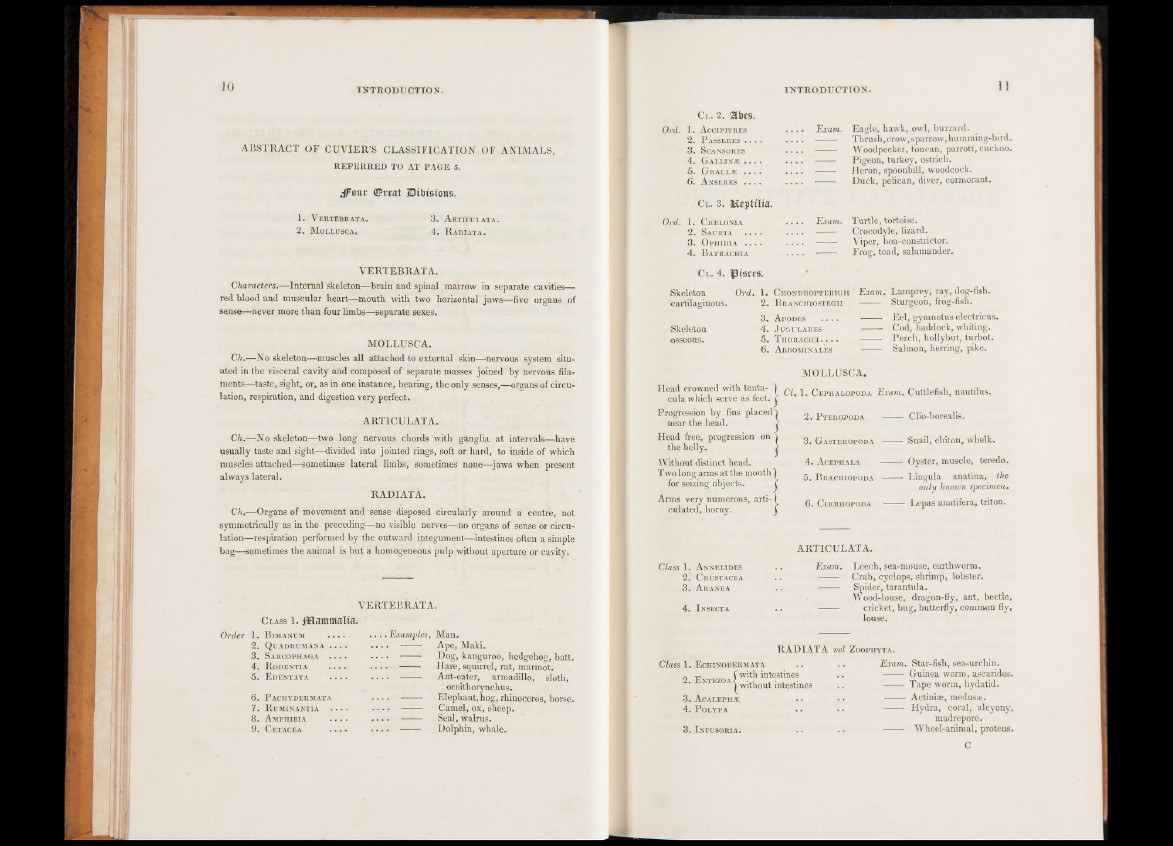
ABSTRACT OF CUVIER’S CLASSIFICATION OF ANIMALS,
REFERRED TO AT PAGE 5.
Jfout ©real 29 ibis ions.
1. V ertebrata. 3. A rtigulata.
2. M ollusca. 4. R adxata.
VERTEBRATA.
Characters.—Internal skeleton—brain and spinal marrow in separate cavities—
red blood and muscular heart—mouth with two horizontal jaws—five organs of
sense—never more than four limbs—separate sexes.
MOLLUSCA.
Ch.—No skeleton—muscles all attached to external skin—nervous system situated
in the visceral cavity and composed of separate masses joined by nervous filaments—
taste, sight, or, as in one instance, hearing, the only senses,—organs of circulation,
respiration, and digestion very perfect.
ARTICULATA.
Ch.—No skeleton—two long nervous chords with ganglia at intervals—have
usually taste and sight—divided into jointed rings, soft or hard, to inside of which
muscles attached—sometimes lateral limbs, sometimes none—jaws when present
always lateral.
RADIATA.
C/i.sS-Organs of movement and sense disposed circularly- around a centre, not
symmetrically as in the preceding—no visible nerves—no organs of sense or circulation—
respiration performed by the outward integument—intestines often a simple
bag—sometimes the animal is but a homogeneous pulp without aperture or cavity.
VERTEBRATA.
C lass f§ fHammalta.
Order 1. B imanum . . . . . . . . Examples, Man.
2. Quadrumana . . . . — . ------ Ape, Maki.
3. Sarcophaga . . . . • • • • ------ Dog, kanguroo, hedgehog, batt.
4. R odentia . . . . . •. • ------1 Hare, squirrel, rat, marmot.
5. E dentata . . ». .....................Ant-eater, armadillo, sloth,
ornithorynchus.
6. P achydermata • ••• ------- Elephant, hog, rhinoceros, horse.
7. R uminantia . . . . Camel, ox, sheep.
8. Amphibia . . . . — . ------ Seal, walrus.
9. C etacea . . . . . . . . ------ Dolphin, whale.
C l . 2. a b e s .
Ord. 1. Accipitres . . . . Exam.
2. P asseres . . . . . . . . -
3. ScANSORES ------ -------
4. G a l l isl e . . . . . . . . ------- 5. G r a l l s e ------ . . . . -------
6. A nseres . . . . . . . . -------
C l. 3. Ifo p ttlia .
Ord. 1. C helonia . . . . Exam.
2. Sauria . . . . . . . . -
3. O phidia . . . . . . . . -
4. Batrachia . . . . -
C l. 4. IJtSMS.
Skeleton Ord. I. Chondropterigii cartilaginous. 2. B ranchiostegii
3. Apodes . . . . Skeleton 4 . J ugulares osseous. 5. T horacici. . . .
6 . Abdominales
Eagle,Thrush h, carwokw,, sopwalr,r obwuz, zhaurmd.ming-bird.
Woodpecker, toucan, parrott, cuckoo.
Pigeon, turkey, ostrich.
Heron, spoonbill, woodcock.
Duck, pelican, diver, cormorant.
Turtle, tortoise. Croeodyle, lizard. Viper, boa-constrictor.
Frog, toad, salamander.
Exam. Lamprey, ray, dog-fish. ------ Sturgeon, frog-fish.
------- Eel, gymnotus electricus.
------ Cod, haddock, whiting.
------- Perch, hollybut, turbot.
------ Salmon, herring, pike.
Head crowned with tenta-
cula which serve as feet.
Progression by fins placed j
near the head. j
Head free, progression on
the belly.
Without distinct head.
Two long arms at the mouth )
for seizing objects. (
Arms very numerous, arti- j
culated, horny. (
MOLLUSCA.
Cl. 1. Cephalopoda Exam.
2 . P teropoda ——I
Cuttlefish, nautilus.
Clio-borealis.
3. G asteropoda ------ Snail, chiton, whelk.
4. Acephala
5. B rachiopoda
6 . Cirrhopoda
Oyster, muscle, teredo.
Linognulyla k noawnna tsipneac,i mtehne.
• Lepas anatifera, triton.
Class 1. Annelides
2. C rustacea
3. A ranea
4. I nsecta
ARTICULATA.
Exam. Leech, sea-mouse, earthworm.
------ Crab, cyclops, shrimp, lobster.
------ WSpoidoedr-,l otaursaen, tudlraa.gon-fly, ant, beetle, ■ cricket, bug, butterfly, common fly,
louse.
RADIATA vel Zoopiiyta.
Class 1. E ciiinodermata „ . „ f with intestines ntezoa^ without intestines
3. Acalephæ
4. P olYPA
3. I nfusoria.
Exam. Star-fish, sea-urchin.
—-— Guinea worm, ascarides.
------- Tape worm, hydatid.
■------■ Actiniae, medusæ.
------ Hydra, coral, alcyony,
madrepore.
------ Wheel-animal, proteus.
C